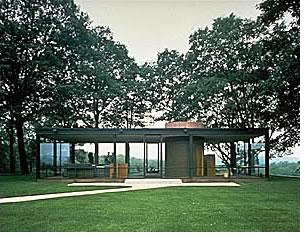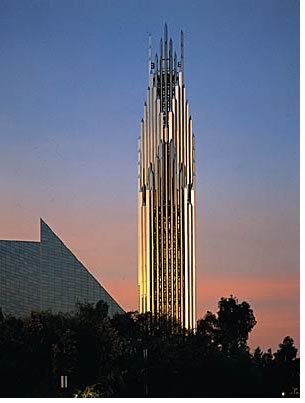

01/2005
 As
a young man and first Architecture Department director for the Museum
of Modern Art, he shocked followers of architectural style with an exhibition
of what he called the International School of Architecture. His masters
degree thesis may have been his first built architectural jest, as the
curator/critic/patron-turned-architect, already known for throwing stones,
designed his own Glass House. Critics of his architecture were often
dismissive of his design work, yet his involvement in such classics as
the Seagram Building in New York and the Museum of Pre-Columbian Art
at Dumbarton Oaks in Washington, D.C., prove his mastery of Modernist
form as well as theory. He may have been signaling boredom with the Modern
style when he designed the 1978, Chippendale-topped AT&T building
in New York; Tycon Towers in Vienna, Va., with its 15-story brick columns;
and awe-inspiring Crystal Cathedral in Los Angeles as he launched Post-Modernism.
In the ’80s, mouths dropped again when
he called himself a whore. And in the ’90s, he announced that he
was gay.
As
a young man and first Architecture Department director for the Museum
of Modern Art, he shocked followers of architectural style with an exhibition
of what he called the International School of Architecture. His masters
degree thesis may have been his first built architectural jest, as the
curator/critic/patron-turned-architect, already known for throwing stones,
designed his own Glass House. Critics of his architecture were often
dismissive of his design work, yet his involvement in such classics as
the Seagram Building in New York and the Museum of Pre-Columbian Art
at Dumbarton Oaks in Washington, D.C., prove his mastery of Modernist
form as well as theory. He may have been signaling boredom with the Modern
style when he designed the 1978, Chippendale-topped AT&T building
in New York; Tycon Towers in Vienna, Va., with its 15-story brick columns;
and awe-inspiring Crystal Cathedral in Los Angeles as he launched Post-Modernism.
In the ’80s, mouths dropped again when
he called himself a whore. And in the ’90s, he announced that he
was gay.
 On January 25, the dean of American architects delivered his final shock.
At 98, three months after announcing
his retirement from his last firm,
Philip Johnson/Alan Ritchie Architects, Philip Johnson, FAIA, died at
home in New Canaan, Conn., in his Glass House.
On January 25, the dean of American architects delivered his final shock.
At 98, three months after announcing
his retirement from his last firm,
Philip Johnson/Alan Ritchie Architects, Philip Johnson, FAIA, died at
home in New Canaan, Conn., in his Glass House.
He criticized the un-aesthetic, commercialized state of architecture in his acceptance speech as the first recipient of the Pritzker Prize in 1979, the year after he received the AIA Gold Medal. But he was never without hope for a return to the recognition of architecture as basic to human activity, he said: “Yet ars longa vita brevis. Values can change. Art, myth, religions can bloom once again. We may, for example, want to rebuild America. We surely can if we want to. We can do anything. We have the skill, the materials, the labor force. Heaven knows, we have the need: our ugly surroundings, our inadequate housing, our sad slums are testimony. We can, if we but will; architecture, as in all the world’s history, could be the art that saves.”
 The Institute mourns
The Institute mourns
“This is indeed sad and sobering news,” said Norman L. Koonce,
FAIA. “And if there is any solace to be had, it is that, unlike the
man, the genius of his work will never die. It will continue to challenge
us and be part of our exploration of our own values and our art. This in
itself is a kind of immortality, a living gift to succeeding generations.”
“Philip Johnson’s work cannot be characterized by a single, consistent style,” said AIA President Douglas L Steidl, FAIA, in memoriam. “Instead, he creatively shaped each design anew in response to the dreams of his clients, the cultural influences of the time, and the intrinsic qualities of the site.
“He was a visionary, contemporary American architect who did not play by the rules, he made them.”
Copyright 2005 The American Institute of Architects.
All rights reserved. Home Page ![]()
![]()
 |
||
|
||